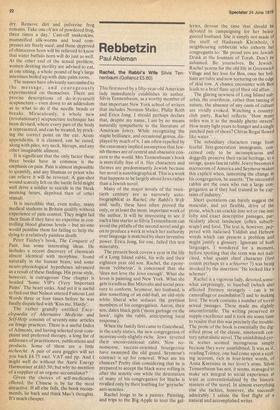Self-help
Elisabeth Whipp
A Barefoot Doctor's Manual (Routledge paperback £5.95) The Conquest of Pain Peter Fairley (Michael Joseph £5.50) The Encyclopedia of Alternative Medicine and Self-Help Edited by Malcolm Hulke (Hutchinson £8.50 hard, £4.95 soft)
All passingly respectable hypochondriacs know very well that the GPs provided by the Welfare State are quite unable to master the intricacies of their delicate metabolisms. Armed with a good dictionary of symptoms, the hypochondriac simplifies the doctor's task by heavily hinting at the obvious diagnosis. Yet most practitioners make a sort of snorting noise and dismiss the patient with another prescription for Valium.
Of the three self-medicating books under review, the Barefoot Doctor's Manual, prepared by the Revolutionary Health Corn
mittee of Hunan Province, China, is by far the most interesting. Never has orthodox Western medicine had to leap through more hoops than in its attempts at mechanistic explanations as to how acupuncture works, or the herbal remedies taught to the highschool graduates who work alongside the peasants.
In deference to Western taste, political propaganda has been left out — but the book still conveys an impression of what it is like to live in such a community. Chairman Mao has had various thoughts on health, and the reader is constantly exhorted to develop the 'revolutionary spirit of saving the dying and aiding the injured in carrying out the humanism of revolution'. War casualties are frequently mentioned and even the future is dealt with under the heading 'outer-space activity, etc . .
Chinese medicine now offers an entire approach to the whole patient which is often lacking in Western medicine, both from new and traditional techniques. China is not short of penicillin — but such remedies are relegated to small type at the end of chapters.
Although the patient is occasionally referred to as 'the victim', this book is comprehensive enough to pass as a Western text-book — apart from its charming translations. Heart murmurs, for example, are described as 'like thunder going lung-lung', or 'thump-thump like wind'. Some of their ideas might seem a little strange to us. The testicles, it is claimed, are needed for hearing. But surely all castrati cannot have been deaf? Perhaps a little revisionism has taken place.
Chinese doctors look at patients and try to determine their degree of yin-ness or yang-ness. Yin includes the cold, internal ailments — paleness, weakness, cold hands and feet, low voice and loss of appetite.
Yang covers the hot, solid external ail ments, characterised by loud-mouthed talkativeness, coarse language and a great thirst — simple categorisations that will no doubt be useful to my hypochondriacal friends.
Herbal treatments are used much more than acupuncture and precise instructions are given for making them up. For some cancers, patients are recommended to concoct: 'live frog, wrapped in dirt, (toasted or baked over fire) until dirt is hardened and dry. Remove dirt and pulverise frog remains. Take one ch'ien of powdered frog, three times a day.' Cast-off snakeskins, mummified silk-worms and toad compresses are freely used; and those deprived of rhinoceros horn will be relieved to know that water buffalo horn will do just as well. At the other end of the sexual problem, women desiring sterility are advised to eat, at one sitting, a whole pound of hog's large intestines boiled up with date palm roots.
The masses have obviously succumbed to the message, and courageously experimented on themselves. There are precise descriptions of do-it-yourself acupuncture — even down to an addendum as to what to do if the needle bends or breaks. Miraculously, a whole new (revolutionary) acupuncture technique has been devised, where every part of the body is represented, and can be treated, by pricking the correct point on the ear. Acute appendicitis, it is claimed, can be cured, along with piles, wry neck, hiccups, and any other imaginable ailment.
It is significant that the only factor these three books have in common is the emphasis on pain. Pain is almost impossible to quantify, and any Shaman or priest who can relieve it will .be revered. A gun-shot wound scarcely felt on the battle field might well drive a soldier to suicide in the bleak morning hours, deprived then of other stimuli.
It is incredible that, even today, many medical students in Britain qualify without experience of pain control. They might fail their finals if they have no expertise in controlling blood glucose levels — but no-one would penalise them for failing to help the dying to a relatively painless death.
Peter Fairley's book, The Conquest of Pain, has some interesting ideas. He includes a recent discovery of chemicals almost identical with morphine, found naturally in the human brain, and some neuro-physiological hypotheses advanced as a result of these findings. His prose style, however, is outrageous: One chapter is headed 'Some VIP's (Very Important Pains'. The heart sinks. And yet it is useful to find out that Nelson uttered Famous Last Words three or four times before he was finally dispatched with 'Kiss me, Hardy'.
The rather grandly entitled Ency
clopaedia of Alternative Medicine and Self-Help consists of seventy-nine articles on fringe practices. There is a useful Index of Ailments, and having selected your complaint and preferred therapy, a long list of addresses of practitioners,, publications and products. Some of them are a little recherche. A pair of aura goggles will set you back £4.75 excl. VAT and pp. And I might well do without the Auric Energy Harmoniser at £65.50; but why no mention of a supplier of an orgone-accumulator?
Given the choices of self-medication offered, the Chinese is by far the most attractive. If all else fails, the book recommends, lie back and think Mao's thoughts. It's much cheaper.















































 Previous page
Previous page